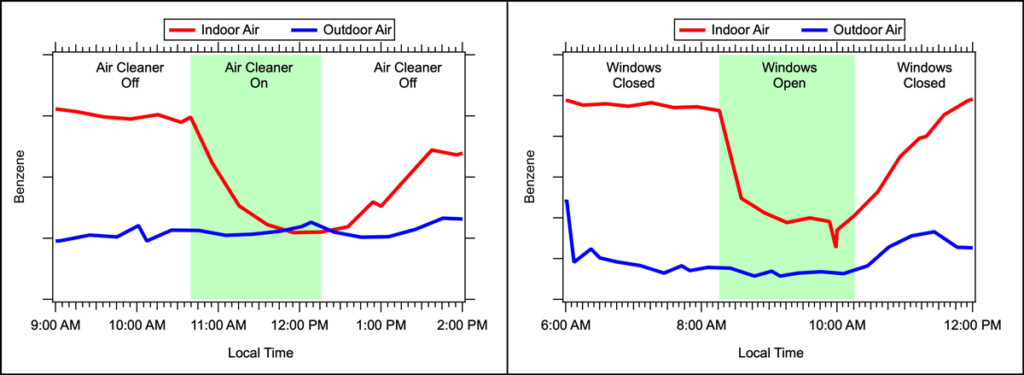In the last days of December 2021, fire raced across the plains of Colorado. By New Year’s Eve, entire neighborhoods were destroyed. Now, the Marshall Fire is considered the most destructive in Colorado history. Not only were more than 1,000 homes in Boulder County burned down (resulting in about $513 million in residential damages), but also residents returning to their neighborhoods were greeted by a noxious burn odor. The smell was worst in surviving homes.
“It’s good that our house is standing, but is it safe to go back?”
“When we first came into the house, the first thing we noticed is how pungent it smells inside,” said Xin Lan, a community member and atmospheric scientist at the University of Colorado Boulder. The smell was unlike that from a wood fire, raising Lan’s concern for her family’s safety: “It’s good that our house is standing, but is it safe to go back?”
Lan was not alone in her concern. A team of local scientists, some personally affected by the fire, quickly gathered instruments, including mass spectrometers and chemical sensors, to begin monitoring the chemicals that filled the air to figure out what the community members were breathing in as they returned home.
In the first step of the study, Joost de Gouw, an atmospheric researcher at the Cooperative Institute for Research in Environmental Sciences (CIRES) at the University of Colorado Boulder who is spearheading the research, asked to install instrumentation in the smoke-damaged homes of some colleagues. As news of his research spread more widely, de Gouw said community members began contacting him through email and even LinkedIn to participate. “This is not driven by the researchers,” said de Gouw. “This is really driven by a need in the community.”

His connections allowed de Gouw to start collecting data days after evacuation orders were lifted. One mass spectrometer was installed in a home only 8 days after the fire burned out. In the weeks after the fire, another mass spectrometer was wheeled into homes to sample the indoor air quality for short amounts of time. Other houses were outfitted with sensors to continuously monitor chemicals in the air.
Air Toxics and Remediation Efforts
After weeks of data collection, it became evident that the air quality impacts of this fire extended beyond the original plume.
After weeks of data collection, it became evident that the air quality impacts of this fire extended beyond the original plume. “We realized there are many unknowns here; this was not a regular wildfire,” said de Gouw. “It was really homes and cars that were burning and not vegetation.”
“We’re very focused on aromatics, or aromatic compounds—benzene, toluene, higher aromatics—because they’re air toxics,” de Gouw said. Continued exposure to high concentrations of volatile organic compounds (VOCs) like these, which come from burning materials, can cause serious health issues such as reproductive effects and birth defects. VOCs can permeate materials like insulation, curtains, and furniture when they burn. These materials can act as reservoirs, releasing VOCs back into the air well after the fire is out, de Gouw said.

The research team’s preliminary data showed elevated concentrations of VOCs in smoke-damaged homes. The research is ongoing: As people continue to move home and begin cleanup, de Gouw’s instruments will measure how cleaning methods affect VOC concentration, shedding light on the efficacy of different techniques. Lan, for one, is participating in this effort—her insurance covered the cost of professional remediation, and the effects will be captured on VOC-detecting instruments in her home.
A homeowner participating in the study…compared the instruments in her home to canaries in a coal mine.
Hazel Bain, a homeowner participating in the study who chose to clean her home herself, compared the instruments in her home to canaries in a coal mine. “For us, it was really reassuring to have something in our house that would actually measure the air quality, because a large part [of our concern] has been the uncertainty of how much cleaning and mitigation to do,” she said.
This ambiguity stems in part from the fact that EPA does not monitor air inside homes, said Christine Wiedinmyer, the CIRES associate director for science and de Gouw’s collaborator. “There’s not a lot out there to tell us that certain mitigation techniques actually make a difference and have an important impact on health,” she said.
De Gouw said his team tends to recommend cleaning smoke-damaged homes by ventilating the house or using air-cleaning devices with activated carbon filters. “Our data indicate [these methods] give short-term relief,” he said, “but it’s not a permanent relief,” because once windows are closed or the air cleaner is turned off, VOCs return to their initial level. As data analysis continues, the efficacy of other cleaning techniques, like those used in professional remediation, will become clearer.
In the future and as residents of Superior and Louisville, Colo., return home, Wiedinmyer and de Gouw hope their work will provide important information to help people assess their own risk and take meaningful measures to reduce that risk after this and future fires.
—Fionna M. D. Samuels (@Fairy__Hedgehog), Science Writer

